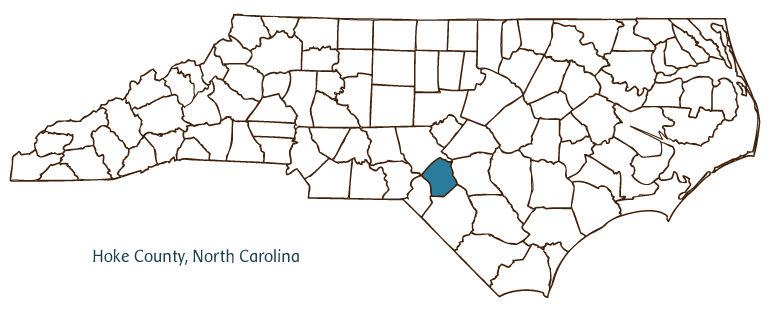Hoke County Resources
- View All:
- Biographies
- Monuments
- locations
Technicians will be working on our network from 5 a.m. to 11 a.m. on Saturday, Dec. 13th. We apologize in advance for any downtime you may experience during this time.
Copyright Notice: This article is from the Encyclopedia of North Carolina edited by William S. Powell. Copyright © 2006 by the University of North Carolina Press. Used by permission of the publisher. For personal use and not for further distribution. Please submit permission requests for other use directly to the publisher.

Hoke County is located in North Carolina's Coastal Plain region in an area originally inhabited by Saura (Cheraw) and Lumbee Indians. The county was formed from Cumberland and Robeson Counties in 1911-the third attempt (after failures in 1907 and 1909) to create a new jurisdiction for disaffected residents of the two counties. Popular support for the successful 1911 campaign hinged on naming the proposed county Hoke in honor of prominent Confederate general and railroad president Robert F. Hoke. Raeford (incorporated in 1901) became the county seat and is the principal city; other communities include Dundarrach and McCain. The Fort Bragg Military Reservation, established and developed in the late 1910s and early 1920s, occupies the northern third of the county.
Near the end of the twentieth century, Hoke County earned distinction as the host of the annual North Carolina Turkey Festival, honoring the state's status as the national leader in turkey production. Originating as the "Hoke Heritage Hobnob" in 1984, the festival was at first a relatively minor one-day affair in Raeford; but in the years following, the event's scope and appeal grew substantially, with up to 60,000 people attending yearly in the early twenty-first century.
Besides turkeys, Hoke County agricultural products include tobacco, corn, soybeans, cotton, hogs, and beef cattle. Manufactured goods include wool and polyester fabrics, beauty aids, and concrete blocks. The county is home to a substantial number of Lumbee Indians. In 2004 the estimated population of Hoke County was 38,600.
For an annotated history of the county's formation, with the laws affecting the county, boundary lines and changes, and other origin information, visit these references in The Formation of the North Carolina Counties (Corbitt, 2000), available online at North Carolina Digital Collections (note, there may be additional items of interest for the county not listed here):
County formation history: https://digital.ncdcr.gov/Documents/Detail/the-formation-of-the-north-ca...
Index entry for the county: https://digital.ncdcr.gov/Documents/Detail/the-formation-of-the-north-ca...
Additional resources:
Corbitt, David Leroy. 2000. The formation of the North Carolina counties, 1663-1943. https://digital.ncdcr.gov/Documents/Detail/the-formation-of-the-north-carolina-counties-1663-1943/3692099?item=4553233 (accessed June 20, 2017).
Hoke County Government: http://www.hokecounty.org/
Raeford-Hoke Chamber of Commerce: https://www.rhchamber.com/
DigitalNC, Hoke County: https://www.digitalnc.org/counties/hoke-county/
North Carolina Digital Collections (explore by place, time period, format): https://digital.ncdcr.gov
Image credits:
Rudersdorf, Amy. 2010. "NC County Maps." Government & Heritage Library, State Library of North Carolina.
Vocci, Robert Blair. "Hoke County." NCpedia. State Library of NC. 2006. https://www.ncpedia.org/geography/hoke.